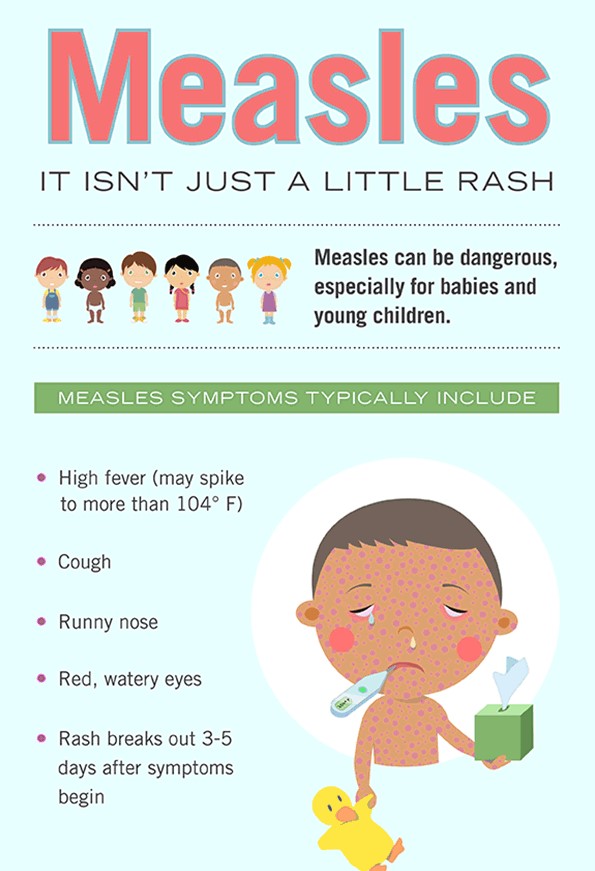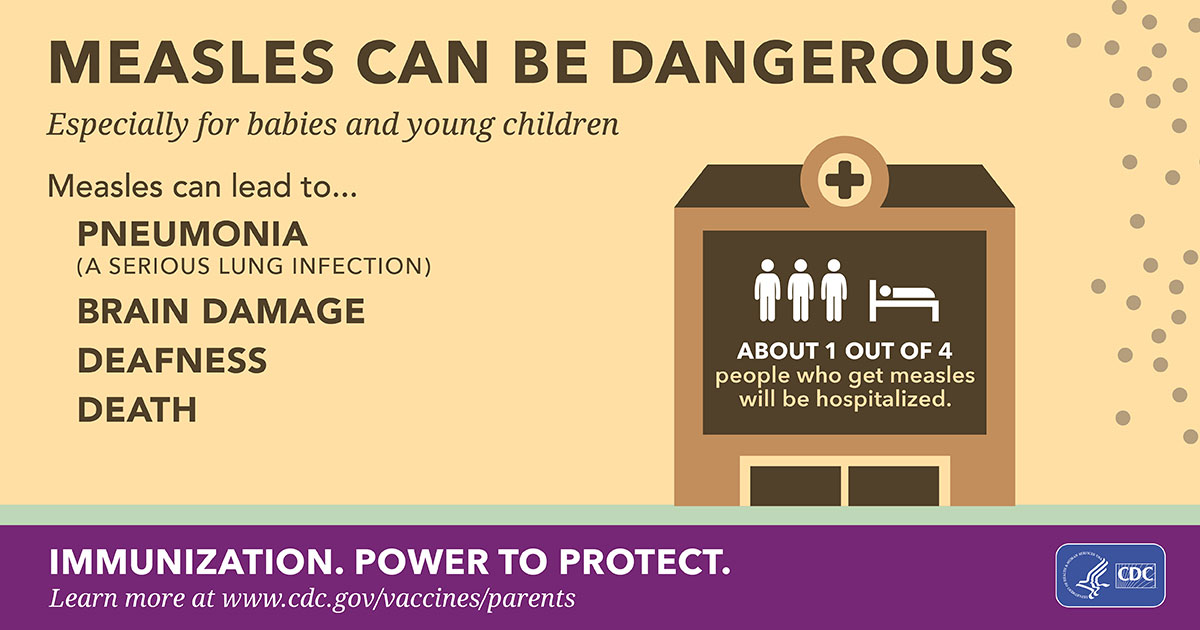DHHS → MeCDC → Disease Surveillance → Epidemiology → Vaccine-preventable Diseases → Measles
Measles
On this page
About
Measles is a respiratory disease caused by a virus that can spread through the air by breathing, coughing, or sneezing. The disease is also called rubeola is easily spread from person to person. Measles causes fever, runny nose, cough, and a rash all over the body. The rash usually begins on a person’s face and spreads down to the neck, trunk, arms, legs, and feet. When the rash appears, a person’s fever may rise to more than 104° Fahrenheit.
Symptoms
Signs and symptoms of measles usually appear about 7 to 14 days after a person is infected. Measles usually begins with:
- High fever
- Cough
- Runny nose
- Red, watery eyes
Two or three days after signs and symptoms begin, tiny white spots (Koplik spots) may appear inside the mouth.
Three to five days after symptoms begin, a rash breaks out. It usually begins as flat red spots that appear on the face along the hairline and spread downward to the neck, trunk, arms, legs, and feet. Small raised bumps may also appear on top of the flat red spots. When the rash begins, a fever may spike to more than 104° Fahrenheit.

Transmission
Measles is a very contagious virus that lives in the nose and throat of an infected person. The main way that measles spreads is by coughing or sneezing. Measles virus can also live on surfaces and in the air where an infected person coughed or sneezed for up to two hours. Up to 9 out of every 10 people close to a person with measles who are not immune will also become infected.
People at Higher Risk
Measles can be serious in all age groups. Certain people are more likely to suffer from measles complications including:
- Children younger than 5 years of age
- Adults older than 20 years of age
- Pregnant women
- People with weak immune systems
Ear infections and diarrhea are common complications from measles. Serious complications include pneumonia and encephalitis and may require hospitalization. Death from measles can occur.

Measles Vaccination
Measles can be prevented with a measles containing vaccine. This includes MMR (measles, mumps, rubella) or MMRV (measles, mumps, rubella, varicella) vaccines. Two doses of a measles containing vaccine are about 97% effective at preventing measles; one dose is about 93% effective. Some people who get two doses may still get measles if they are exposed to the virus, however the disease is usually milder and they are less likely to spread the disease to others.
Vaccination recommendations are:
- Children: All children should receive two doses of MMR. The first dose should be given at 12 through 15 months of age and the second at 4 through 6 years of age. CDC does not recommend measles vaccine for infants younger than 6 months of age.
- Adults: All adults should have proof of immunity to measles. For adults with no evidence of immunity to measles, 1 dose of MMR vaccine is recommended, unless the adult is in a high-risk group in which case 2 doses of MMR vaccine are recommended. High risk groups include international travelers, travelers to areas in or outside of the U.S. with ongoing measles transmission, health care workers, and college students. Live vaccines, including MMR vaccine, should not be given during pregnancy.
Recommendations related to vaccination prior to travel – whether to an area with a known measles outbreak in the U.S., or to any destination internationally – are outlined below, in the Travel section.
US CDC recommends that individuals born between 1957 and 1967 check their measles vaccination history. While most people in this age group have some immunity, some may need extra protection. You may need another measles vaccination if:
- You received the inactivated (killed) measles vaccine between 1963 and 1967. This version was ineffective.
- Get vaccinated with at least one dose of the live, attenuated (weakened) MMR vaccine.
- If you are not sure about your vaccination history or immunity.
- Get an extra dose of the live attenuated MMR vaccine.
- You are in a high-risk group. This includes health care workers, international travelers, and individuals in outbreak prone areas.
- Talk to a health care provider to make sure you are fully protected.
Find more details on measles vaccination from US CDC.
Travel
Measles cases in the US originate from international travel or domestic travel to an area of the U.S. with an outbreak. The best way to protect yourself from getting measles is by getting vaccinated.
Prior to planned travel, whether internationally, or within the U.S. to an area with active measles transmission, the Maine CDC recommends the following guidance:
- Plan to be fully vaccinated at least 2 weeks before you depart.
- If your trip is less than 2 weeks away and you're not protected against measles, you should still get a dose of MMR vaccine.
- Children who are 6 through 11 months of age should receive 1 dose of MMR vaccine followed by the routinely recommended dose at 12--15 months, and a final dose at 4--6 years.
- If MMRV is given at 12 months, the following MMRV vaccine should be given no earlier than 3 months after.
- Please note MMRV is not licensed for children younger than 12 months of age.
- Children who are aged at least 12 months should receive 2 doses of MMR separated by at least 28 days.
- If MMRV is used, doses must be given at least 3 months apart.
- Teens and adults with no evidence of immunity should receive 1 MMR dose immediately and a second dose 28 days after the first dose.
- Teens and adults with acceptable evidence of immunity are not recommended for an additional MMR vaccination prior to travel.
- Acceptable evidence of immunity against measles includes at least one of the following:
- Written proof of adequate vaccination (two doses for travel to high-risk areas)
- Laboratory evidence of immunity
- Laboratory confirmation of measles
- Birth in the United States before 1957
After travel: Watch for measles
- Monitor for symptoms (fever, cough, runny nose, watery eyes, rash)
- Call a healthcare provider immediately if you think you or your child have been exposed to measles
Information for Health Care Professionals
- Measles Information for Healthcare Professionals
- Maine Measles Surveillance Reports 2017 | 2018 | 2019 | 2020 | 2021 (PDF)
- Measles Cases and Outbreaks
- Laboratory Testing for Measles
- US CDC Measles Resources
Resources
- Measles Fact Sheet (English) (PDF)
- Think Measles One Pager for Health Care Providers (PDF)
- US CDC: Measles
- Measles Frequently Asked Questions

